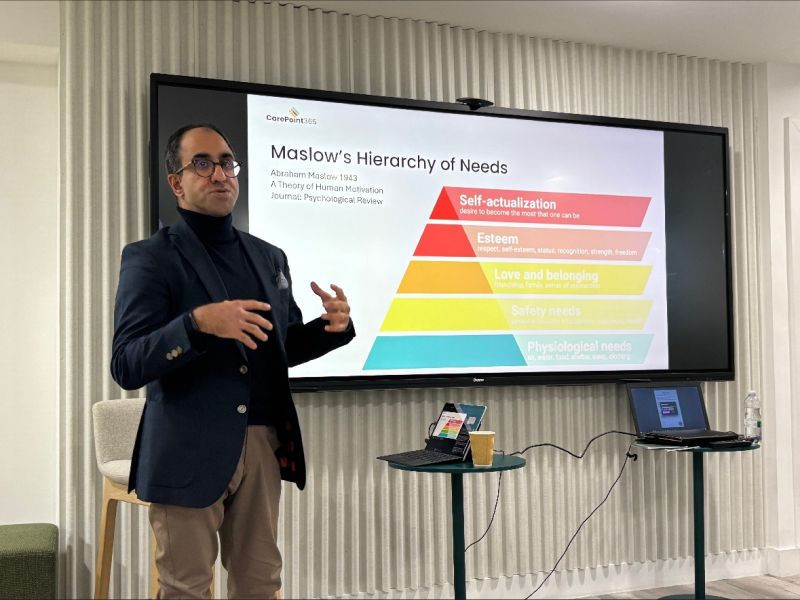For Sarj Radia, the Care Tech Avengers isn’t just another project; it’s a personal undertaking rooted in over a decade of experience technology within the care sector. “Once you get involved in social care, you’re not going anywhere else,” he says. “It gives everyone a purpose.”
The challenges in social care are numerous and known, with chronic underfunding and vacancies only exacerbated by the Autumn Budget’s changes to pay and National Insurance. Yet despite this, Sarj remains optimistic. He describes the sector as one of the most resilient he has encountered. “It’s filled with empathetic people who band together to tackle problems. Everyone is doing their best within the constraints we have.”
The Care Tech Avengers was born out of this collective spirit. The idea was simple yet powerful: bring together the best minds in care and technology to help providers navigate their challenges and unlock the sector’s potential.
“We’re not a corporate initiative,” Radia emphasises. “This isn’t about making money ... [it] is about support by running workshops, thought leadership events, and creating a platform for collaboration.”
The challenges facing providers
One of the recurring themes in Sarj’s discussions with care providers is the aspiration to use data effectively. “Everyone wants to leverage data to improve efficiencies and care delivery,” he says. However, achieving this goal often proves challenging due to systemic blockers in the way software is designed and implemented.
Sarj highlights a common issue: “When care providers adopt SaaS [Software as a Service] platforms, they often find that the software only meets about 60-70 per cent of their needs. Even in the best-case scenario, it might cover up to 90 per cent, but rarely more than that. This gap leaves providers struggling to adapt their workflows or integrate disparate systems.”
These challenges are compounded by a lack of time and resources. “Care providers are time-poor and often don’t have the bandwidth to thoroughly vet or customise technology solutions,” Radia notes. This can lead to poor adoption rates and fragmented data, which ultimately undermines the potential benefits of technology.
Unlocking data
Despite these challenges, Sarj remains hopeful about the transformative potential of data in social care. He envisions a future where rich, actionable data improves every aspect of care delivery, from workforce management to compliance.
“At a basic level, data can help with staffing,” he explains. “Knowing your staff’s skill sets and locations allows you to match them to the right care settings. Accurate scheduling reduces anxiety for employees, while better matching improves care quality for service users.”
We need to ensure our IT systems are robust ... The applications are endless, but we need to approach them with respect and caution.
Sarj also highlights the potential for data to reduce staff turnover. “When staff feel supported and stable, they’re more likely to stay. This stability feeds back into better compliance and higher-quality care, creating a virtuous cycle.”
However, Radia cautions against over-reliance on dashboards and reports. “Clinical staff don’t want to sift through bar charts or complex dashboards. The goal should be to deliver insights directly to the people who need them, using AI and automation to flag critical information.”
The role of AI
As the conversation shifts to AI, Sarj acknowledges its immense potential but also stresses the need for caution. “AI isn’t a silver bullet. It needs guardrails and should be deployed thoughtfully,” he says.
One promising area is visual AI, which is already being used in applications like fall detection and behaviour monitoring. “These tools can provide critical insights for carers and nurses without being intrusive,” Sarj explains. “For example, AI can identify antecedents to behavioral incidents or help prevent falls by analysing environmental factors.”
However, Sarj believes the sector must first focus on getting the basics right before fully embracing AI. “We need to ensure our IT systems are robust and that we’re comfortable with the technology before rolling it out in live environments. The applications are endless, but we need to approach them with respect and caution.”
Sustaining momentum
The pandemic acted as a catalyst for tech adoption in social care, but Sarj warns that sustaining this momentum will require ongoing investment and collaboration. “Early adopters will always lead the way, but for widespread adoption, the sector needs more funding and support,” he says.
Sarj also sees a need for cultural change within care organisations. “We need project managers who can treat care businesses like digital transformation projects. This shift will help providers adopt technology more effectively.”
At its core, Care Tech Avengers is about fostering collaboration across the sector. “We’re not a club of cool kids,” Sarj jokes. “Everyone is invited ... care providers, tech developers, policymakers, and anyone with an interest in improving social care.”
A call for government support
As we wrap up, Sarj reflects on the role of government in accelerating tech adoption in social care. “Grant funding has been a great catalyst ... don’t turn that tap off,” he urges. “But we also need to attract younger talent to the sector. Without fresh minds, we risk losing innovation and the perspective of the next generation.”
Sarj believes that with the right resources and collaboration, social care can lead the conversation on tech adoption. “There’s so much untapped potential in this sector. If we get the right people in the room, we can crowdsource solutions, pilot new ideas, and create real change.”
The Care Tech Avengers is still in its early days, but the vision is clear: to create a platform where the best minds in care and technology can come together to solve the sector’s biggest challenges. “This isn’t about finding a single solution,” Sarj concludes. “It’s about trying, collaborating, and making progress one step at a time.”
With its mission to unite and empower the sector, this initiative has the potential to foster solutions that enhance efficiency, data use, and workforce stability. With continued investment and fresh perspectives, it promises to champion meaningful change for a sector that for too long, particularly in Westminster, has gone ignored and unheard.



